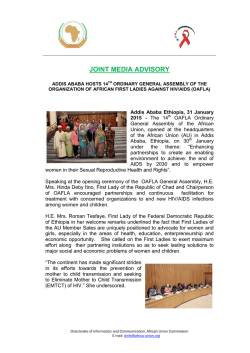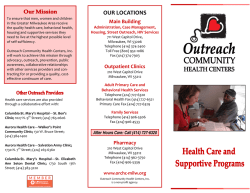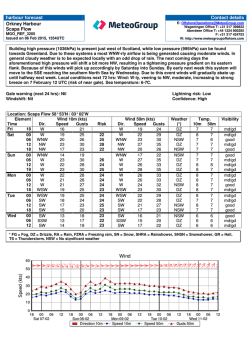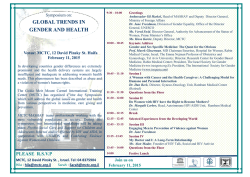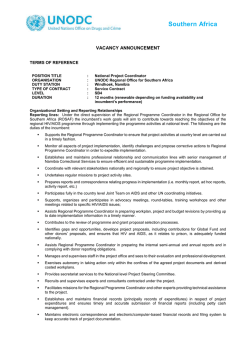
(HIV) - Management of Non-Occupational Exposure
Policy Directive Ministry of Health, NSW 73 Miller Street North Sydney NSW 2060 Locked Mail Bag 961 North Sydney NSW 2059 Telephone (02) 9391 9000 Fax (02) 9391 9101 http://www.health.nsw.gov.au/policies/ space space Human Immunodeficiency Virus (HIV) - Management of Non-Occupational Exposure space Document Number PD2015_005 Publication date 28-Jan-2015 Functional Sub group Clinical/ Patient Services - Infectious diseases Clinical/ Patient Services - Pharmaceutical Clinical/ Patient Services - Medical Treatment Clinical/ Patient Services - Incident management Population Health - Communicable Diseases Summary This policy relates to management of individuals non-occupationally exposed to human immunodeficiency virus (HIV) through the immediate delivery of post exposure prophylaxis as a prevention intervention, particularly where exposures have resulted from unprotected sexual activity and injecting drug use. Replaces Doc. No. Human Immunodeficiency Virus (HIV) - Management of Non-Occupational Exposure [PD2006_005] Author Branch Centre for Population Health Branch contact Applies to Local Health Districts, Board Governed Statutory Health Corporations, Specialty Network Governed Statutory Health Corporations, Affiliated Health Organisations, Public Health System Support Division, Community Health Centres, Government Medical Officers, Ministry of Health, Public Health Units, Public Hospitals, NSW Health Pathology Audience Clinical, nursing, emergency departments, general practitioners, pharmacy Distributed to Public Health System, Divisions of General Practice, Government Medical Officers, NSW Ambulance Service, Ministry of Health Review date 28-Jan-2020 Policy Manual Patient Matters File No. 13/4300 Status Active Director-General space This Policy Directive may be varied, withdrawn or replaced at any time. Compliance with this directive is mandatory for NSW Health and is a condition of subsidy for public health organisations. POLICY STATEMENT HUMAN IMMUNODEFICIENCY VIRUS (HIV) – MANAGEMENT OF NONOCCUPATIONAL EXPOSURE PURPOSE This Policy Directive outlines the service obligations of Local Health Districts (LHDs) in the management of individuals who have been exposed or suspected to have been exposed to HIV in a non-occupational setting. Evidence suggests that the timely provision of post-exposure prophylaxis (PEP) following a non-occupational exposure may prevent subsequent HIV infection. Prescribing of PEP must be based on a careful risk assessment of the risk of HIV infection in accordance with the national guidelines Post Exposure Prophylaxis after Non-Occupational and Occupational Exposure to HIV published in December 2013 (‘National PEP Guidelines’). This Policy Directive should be read in conjunction with National PEP Guidelines, which provide comprehensive clinical guidance on PEP provision. MANDATORY REQUIREMENTS LHDs are responsible for the cost of drugs used in PEP, and for ensuring that prescribing is conducted in accordance with the National PEP Guidelines. LHDs must ensure that local PEP services address the time-critical nature of PEP assessment and commencement, and provide prompt referral and follow-up of all patients prescribed PEP. Compliance with this Policy Directive is mandatory for all health care providers in receipt of funding from NSW Health, including Local Health Districts and Chief Executive Governed Statutory Health Corporations, and Affiliated Health Organisations (both declared and undeclared), and their staff. IMPLEMENTATION Chief Executives of LHDs, Statutory Health Corporations and Affiliated Health Organisations in receipt of funding from NSW Health are responsible for ensuring that: • Local policies and procedures are in place to ensure provision of PEP in accordance with the National PEP Guidelines (Section 2) • PEP drug provision is funded through the LHD • All staff are made aware of their obligations in relation to this Policy Directive; and • All staff receive appropriate training to enable them to carry out their obligations in relation to this Policy Directive. All staff must comply with this Policy Directive. PD2015_005 Issue date: January-2015 Page 1 of 2 POLICY STATEMENT REVISION HISTORY Version January 2015 PD2015_005 January 2006 PD2006_005 Approved by Deputy Secretary, Population and Public Health Director General Amendment notes Replaces Policy Directive PD2006_005 Replaces Guideline GL2005_022 ATTACHMENTS 1. Human Immunodeficiency Virus (HIV) – Management of Non-Occupational Exposure - Procedures. PD2015_005 Issue date: January-2015 Page 2 of 2 Human Immunodeficiency Virus (HIV) – Management of Non-Occupational Exposure PROCEDURES Issue date: January-2015 PD2015_005 Human Immunodeficiency Virus (HIV) – Management of NonOccupational Exposure PROCEDURES CONTENTS 1 BACKGROUND ....................................................................................................................1 2 PROCEDURES FOR MANAGEMENT OF HIV NON-OCCUPATIONAL PEP....................... 2 2.1 General requirements for Local Health Districts (LHDs) ................................................ 2 2.2 HIV status of the source individual ................................................................................2 2.3 HIV status of the exposed individual ..............................................................................2 2.4 Management of possible exposure to other conditions ..................................................2 2.5 Recording information where a patient is assessed for PEP .......................................... 3 2.6 Patient confidentiality ....................................................................................................3 2.7 Quality assurance..........................................................................................................3 3 APPENDIX............................................................................................................................4 3.1 Contacts and information for health care workers ..........................................................4 3.2 Community services ......................................................................................................4 3.3 Legislation, policies and resources ................................................................................5 PD2015_005 Issue date: January-2015 Contents page Human Immunodeficiency Virus (HIV) – Management of NonOccupational Exposure PROCEDURES 1 BACKGROUND This Policy Directive specifies the service obligations of Local Health Districts (LHDs) in the provision of Post Exposure Prophylaxis (PEP) for non-occupational HIV exposure. It should be read in conjunction with the national guidelines Post-Exposure Prophylaxis after Non-Occupational and Occupational exposure to HIV published in December 20131 (‘the National PEP Guidelines’), which provide comprehensive clinical guidance. There is evidence in relation to HIV that PEP may prevent infection2, although there are currently no data from randomised controlled trials of PEP efficacy. The prescribing of PEP must be based on a careful assessment of the risk of HIV infection in accordance with the National PEP Guidelines. PEP should be prescribed as soon as possible after exposure and within 72 hours3. Drugs used in PEP are not currently funded through the s100 program. LHDs are responsible for the cost of drugs used in PEP, and for ensuring drugs are prescribed in accordance with the National PEP Guidelines. Treatment prescribed at a patient’s first presentation, usually sufficient for one week, is a bridging step until the client is fully assessed by an authorised s100 prescriber or specialist affiliated with a designated HIV/AIDS Unit. LHDs must ensure that PEP services address the time-critical nature of PEP assessment and commencement, and the need for prompt referral and follow-up of all patients who are prescribed PEP. The occupational exposure of health care workers to the risk of HIV infection is dealt with in the NSW Health Policy Directive PD2005_311 HIV, Hepatitis B, and Hepatitis C – Management of Health Care Workers Potentially Exposed. 1 http://www.ashm.org.au/pep-guidelines/NPEP_PEP_guidelines_Dec_2013.pdf J Hoy, S Lewin, JJ Post, A Street. HIV Management in Australasia: A Guide for Clinical Care. Australasian Society for HIV Medicine, 2009. 3 National PEP Guidelines at p.8 2 PD2015_005 Issue date: January-2015 Page 1 of 6 Human Immunodeficiency Virus (HIV) – Management of NonOccupational Exposure PROCEDURES 2 PROCEDURES FOR MANAGEMENT OF HIV NONOCCUPATIONAL PEP 2.1 General requirements for Local Health Districts (LHDs) LHDs are required to have policies and procedures in place that ensure provision of PEP in accordance with the National PEP Guidelines, including: • • • • • • • • • • • Emergency response and assessment of the patient to ensure timely administration of PEP where indicated, as soon as possible after exposure and within 72 hours Access 24 hours-a-day to expert advice and guidance on clinical best practice treatment and management of recent HIV exposure Ready access to drugs used for PEP Information about PEP for the patient Informed consent of the patient Prescribing and dispensing of medication Baseline and follow up testing for HIV Assessment of risk of exposure to other infections, with immunisation, testing and treatment as indicated Provision of, or referral for, follow-up assessment and ongoing monitoring by an authorised s100 prescriber, or specialist affiliated with a designated HIV/AIDS Unit, preferably in the patient’s local area Referral to specialist counselling and peer support services where indicated Referral to services that offer ongoing blood borne virus (BBV) and sexually transmissible infection (STI) testing and management, such as publicly funded sexual health services, as patients presenting for PEP are often at a high, ongoing risk for other BBVs and STIs. 2.2 HIV status of the source individual Attempts should be made to contact the source and ask them to have an urgent HIV test. Where possible obtain information about the source individual including HIV status, and if HIV positive, including viral load, whether on treatment, which treatment, any treatment failures or known resistance. Initiation of PEP should not be delayed while establishing the HIV status of the source. 2.3 HIV status of the exposed individual All candidates for PEP require baseline HIV antibody testing. Where possible, the results should be followed up within 24 hours. Initiation of PEP should not be delayed while determining the HIV status of the exposed individual. 2.4 Management of possible exposure to other conditions Hepatitis B PD2015_005 Issue date: January-2015 Page 2 of 6 Human Immunodeficiency Virus (HIV) – Management of NonOccupational Exposure PROCEDURES All patients presenting for PEP must be assessed for possible hepatitis B exposure, and tested and provided with immunisation including hepatitis B immunoglobulin where indicated4. Other conditions for which testing may be indicated, depending on the nature of the exposure, are listed below: See the National PEP Guidelines for a recommended schedule of baseline and follow-up testing for these conditions in conjunction with PEP assessment 5. Sexually transmissible infections Patients are to be tested for chlamydia, gonorrhoea, and syphilis, as indicated by the type of exposure. Hepatitis C Patients who are potentially at risk of hepatitis C infection after exposure require followup and specialist referral if seroconversion is detected. Pregnancy All women who have the potential to be pregnant on presentation for PEP should be offered pregnancy testing. Emergency contraception should be offered to women presenting for PEP who are at risk of pregnancy. Follow-up pregnancy testing should be offered at two weeks post-exposure where indicated. If the test is negative but pregnancy is still suspected, the test should be repeated in 1 week. Specialist advice must be sought urgently for women who require PEP and are pregnant or breastfeeding. 2.5 Recording information where a patient is assessed for PEP Every assessment for PEP must be documented, regardless of whether PEP is commenced. The required information covers the time of the assessment and first dose (if prescribed), details, including date and time of the exposure, information about the exposed person (including any previous HIV test and result), information about the source, details of PEP discussion with the patient, referral, and follow-up arrangements. Further details are provided in the National PEP Guidelines6. 2.6 Patient confidentiality The confidentiality of the patient and the source must be maintained in accordance with the requirements of the Public Health Act 2010 (NSW). 2.7 Quality assurance LHDs must have a quality assurance process in place to monitor and review the effectiveness of arrangements for managing exposed individuals, including in relation to health outcomes for patients. 4 5 6 National PEP Guidelines at p.15 At p.8 National PEP Guidelines at p.11 PD2015_005 Issue date: January-2015 Page 3 of 6 Human Immunodeficiency Virus (HIV) – Management of NonOccupational Exposure PROCEDURES 3 APPENDIX 3.1 Contacts and information for health care workers List of NSW HIV s100 prescribers by suburb: http://www.ashm.org.au/images/prescriber/ashmprescribers.pdf Australasian Society for HIV Medicine Tel: 02 8204 0700 NSW HIV Support Program Tel: 02 9391 9195 Email: [email protected] Support for doctors and patients where the patient is newly diagnosed with HIV Needlestick Hotline Tel: 1800 804 823 Information and support for healthcare, paramedical, and emergency services workers, who sustain a needlestick injury and/or experience occupational exposure to blood and body fluids NSW Sexual Health Infolink Tel: 1800 451 624 TTY: 9221 6515 NSW Sexual Health Clinics Phone the NSW Sexual Health Infoline for information about clinics and services in your area: 1800 451 624 www.health.nsw.gov.au/sexualhealth/pages/sexualhealth-clinics.aspx NSW AIDS Dementia and HIV Psychiatry Service Tel: 02 9382 8600 www.nsw.health.gov.au/adahps Needle Cleanup Hotline Arranges clean-up of dumped needles and syringes in public places anywhere in NSW Tel: 1800 633 353 Community services ACON Tel: 1800 063 060 www.acon.org.au Provides health promotion services specialising in people living with with HIV and lesbian, gay, bisexual, transgender and intersex (LGBTI) health. NSW PEP Hotline Tel: 1800 737 669 Information, assessment, and referral of people who may require HIV PEP following a high risk exposure (not an information line for general questions about HIV). PD2015_005 Issue date: January-2015 Page 4 of 6 Human Immunodeficiency Virus (HIV) – Management of NonOccupational Exposure PROCEDURES Multicultural HIV and Hepatitis Service Tel: 02 9515 1234 Free call (NSW country): 1800 108 098 www.mhahs.org.au A statewide service providing information and assistance for culturally and linguistically diverse communities. NSW Users and AIDS Association (NUAA) Tel: 02 8354 7300 Tel (NSW Country): 1800 644 413 http://www.nuaa.org.au/ Provides information and support for users of illicit drugs, and their families and friends, as well as needle and syringe program services. PozHet Information Line: 1800 812 404 http://pozhet.org.au/ Provides support for heterosexual people with HIV. Positive Life NSW Tel: 02 9206 2177 Free call: 1800 245 677 http://www.positivelife.org.au/ Provides support for people living with HIV. Sex Workers Outreach Project Tel: 02 9206 2000 www.swop.org.au Provides sexual health information and support to people who engage in sex work. HIV Information Line Tel: 1800 451 600 Information, support, and referral, about HIV. 3.2 Legislation, policies and resources National Guidelines for Post-Exposure Prophylaxis after Non-Occupational and Occupational Exposure to HIV. Australasian Society for HIV Medicine, 2013 http://www.ashm.org.au/pep-guidelines/NPEP_PEP_guidelines_Dec_2013.pdf HIV, Hepatitis B, and Hepatitis C – Management of Health Care Workers Potentially Exposed. NSW Health Policy Directive PD2005_311 http://www0.health.nsw.gov.au/policies/PD/2005/pdf/PD2005_311.pdf Public Health Act 2010 (NSW) http://www.austlii.edu.au/au/legis/nsw/consol_act/pha2010126/ Public Health Regulation 2012 (NSW) PD2015_005 Issue date: January-2015 Page 5 of 6 Human Immunodeficiency Virus (HIV) – Management of NonOccupational Exposure PROCEDURES http://www.austlii.edu.au/au/legis/nsw/consol_reg/phr2012217/ PD2015_005 Issue date: January-2015 Page 6 of 6
© Copyright 2024
